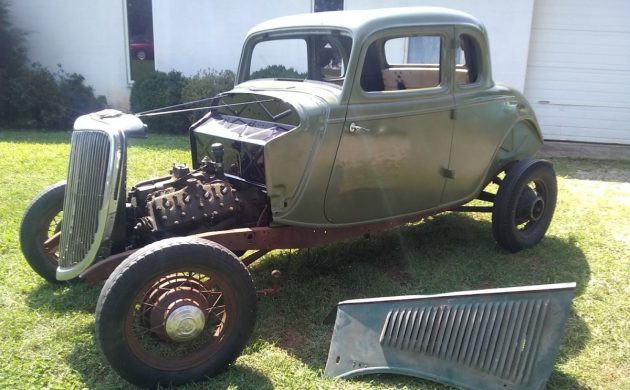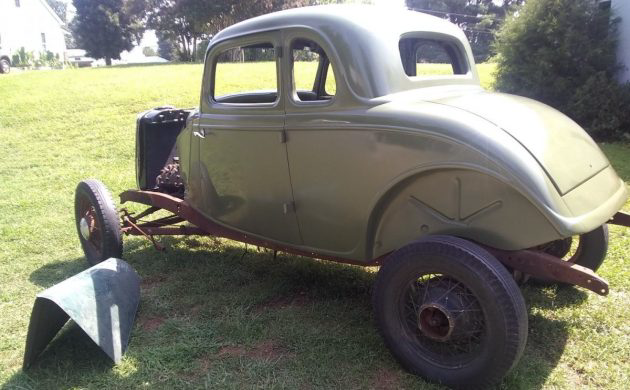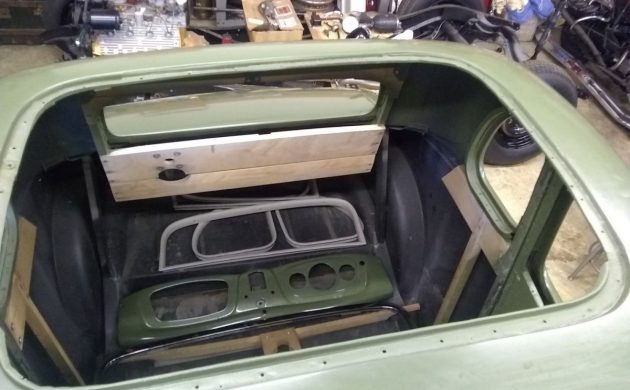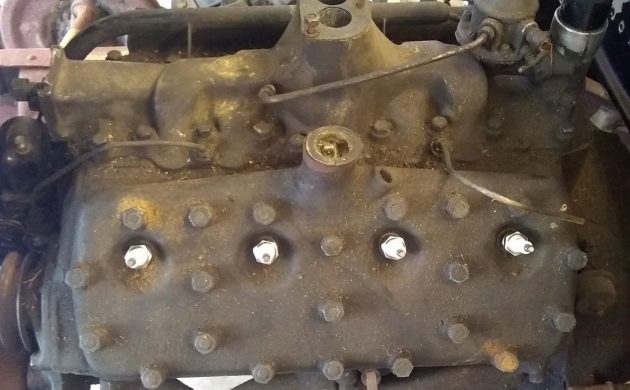Every restoration starts with disassembly. This is sort of like having dessert before dinner. It is fun to take things apart, and it doesn’t require a lot of meticulous work. The problem is that if you aren’t photographing and documenting the removal of every part and piece, the road to completion can be a long one. Even more difficult is when someone else takes the car apart. Take for example this 1934 Ford five window coupe, for sale on eBay in Goodview, Virginia. The previous owner has obviously spent a lot of time and money restoring parts of this solid car. However, with bidding currently at $12,800, is the price worth the hassle of puzzle piecing this snazzy coupe back together again?
The story from the seller is that the body is real Henry steel, which is code for an original body and not a reproduction one. This body was sent to a fellow named Josh Mills for metalwork and painting. This gentlemen then made all of the necessary metalwork repairs, and then sprayed the body with 20 coats of military green lacquer. There is no notation as to when this happened. Lacquer paint is still available, but usually at stratospheric costs. This type of paint is not used much because of environmental concerns and the lower cost of alternative finishes. Lacquer does have a market among restorers who are meticulous about having a factory correct restoration.
From there, the story gets mildly fuzzy. The body was purchased four years ago, but it is stated that the original body is being sold with the original chassis with all the 1934 pedals, linkage, wheels, dash, etc. The way it is written sounds like they either came from two different vehicles, or the intention was to put the body on another chassis. However it was meant, what you do have is an original chassis that looks to be unrestored, a body that has been restored, and an engine out of a 1937 Ford. Some assembly required.
As we look down into the interior, we see that the wood framework has been replaced in this old Ford. We can also see the chrome windshield frame and windshield, the dash, and the garnish moldings. There is no sign of the seat frames or springs, but the windows roll up and down in the doors.
Under the hood is a 21 stud Flathead Ford, but not the correct one for the car. This engine is out of a 1937 Ford that was barn kept and had just 40,000 miles on it. You can tell the difference between a 21 and 24 stud Flathead by, among many other less obvious ways, by the location of the water pumps and the water outlets. Engines built from 1932 through 1936 had water pumps that mounted to the front of the cylinder heads and a water outlet at the front as well. 1937 through 1938 engines had water pumps mounted to the block and water outlets in the center of the head, which was a design change meant to cool the engine a bit better. This engine is missing the generator, carburetor, and a few other bits and pieces. Hopefully the seller has these parts, and can give a perspective buyer a bit more information about the condition of the engine.
Obviously this would be a neat project. 1934 Ford had beautiful lines, and the five window coupe versions are one of the most sought after body styles. Hot rodders love these cars, and often chop the tops and channel the bodies for that wicked look. I just hope the next owner doesn’t go that route. There just aren’t many uncut five windows left running around anymore. This five window deserves a proper restoration and a return to the road.
Are you the one to pick up the pieces and put it back together again?












I would love to take on a project like this one. I’m much better at chassis/driveline restoration than bodywork. Most of the engine blocks of this era were replaced with the ones with the precision insert mains (that came out in late ’36). My ’35 and my ’35 spare engine both use the newer blocks. The later block is actually a ’37/early ’38 as it uses blanks where the water pumps would go. The only difference (other than the heads) is the use of flat-top pistons up to ’36 and domed pistons from ’37 on. I’ve seen a lot of these cars with 24 stud blocks and they work just fine too….
I would also love to take it on if I had the garage space. All the hard work is done. Up to 17K with 10 hours to go.
Watch for a last minute price surge on this one…..
So, this car “sold” on ebay 8/26 for high bid of $18750 which is probably around right money with as nice as the body appears. The winning bidder had over 2k feedbacks so likely wasn’t an ebay flake. But obviously he backed out, perhaps because in his excitement to acquire it he failed to notice there is no title. The bidding this time around is tracking in similar fashion to the previous auction with some of the same bidders so it will probably end up somewhere around the same money. Depending on where the buyer lives a bonded title (with varying levels of restrictions and pita application processes) can solve the title issue, but is still a negative for many.
Although personal inspection would be best, and the description is weak, the body does appear pretty nice, the floor is impressive. If the plating is sound that’s a nice grille and windshield, and the radiator looks newish. The roof wood while new looks incomplete, but could just be lousy presentation.
Considering how weak the project car market in this segment has been the past couple years this is pretty good money for a fenderless car. While asking prices are all over the place, actual sales for running/driving hot rodded versions with fenders are in the $35k, plus/minus range, with stockers just a tad softer. At 18ish you could easily double your cost to get this to a comparable level, but you would have it featured exactly the way you’d want it instead of some level of compromise on the details. Either way, it’s not going to be an “investment” except for the fun value.
As always Uncle Bob and I are coming from the same place. I have owned my 34 5-window (Hot Rod) 55 years, so I have some knowledge of this make and model. This car appears way above average condition, and most of the parts especially the sheet metal is there and looks very good. The missing fenders, not so good, but re-pop steel is available but pricey. I see no inner fender panels ,splash apron and the dash has extra holes, all the parts are 34 and certainly worth using. Uncle Bobs last paragraph says exactly what I would, I am just phrasing it different. I think his retail for a 34 Coupe is about right, maybe exception for the real high end, but no matter these cars are depreciating, and that I think is Bobs point and mine, he was just more polite “Not an investment, except for fun value”. The only person who will profit in dollars from this would be ,if the buyer takes it to a professional builder, otherwise a labor of “Love” ,and there is nothing wrong with that ,just don’t lie to yourself. Maybe your wife, but I would never admit I said that!
Thanks for the comments uncle Bob, bit like a reality check on a highly prized commodity & a fair assessment of just how tantalising this one is…!
You can also tell a 21 stud engine from a 24 by counting the bottom row of studs. 21 has 5, 24 has 8.